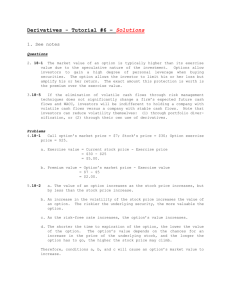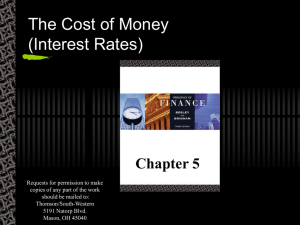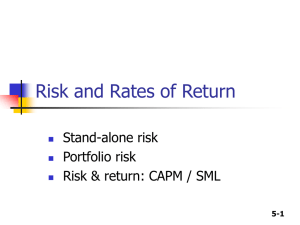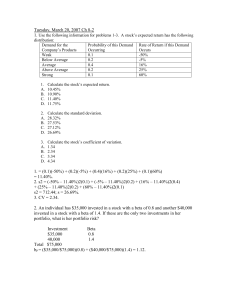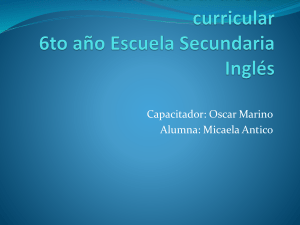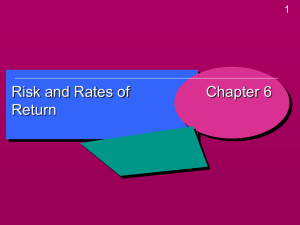Interest Rates
advertisement
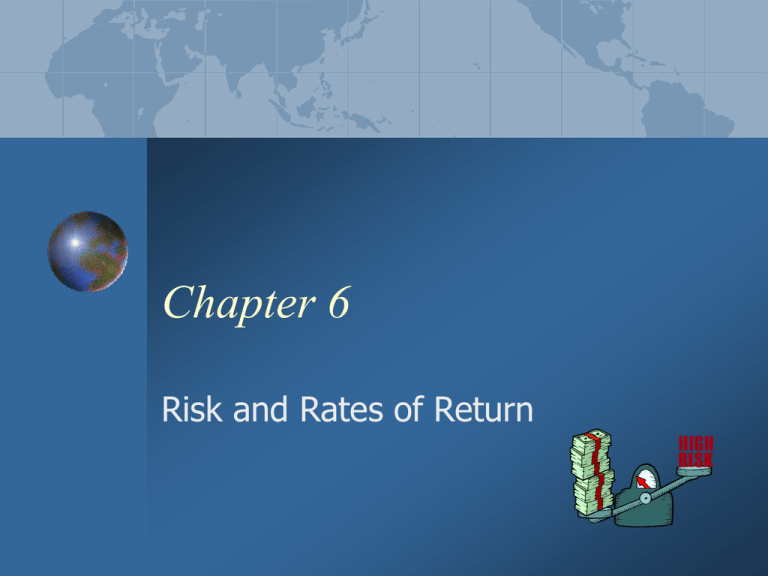
Chapter 6 Risk and Rates of Return Chapter 6 Objectives Inflation and rates of return How to measure risk (variance, standard deviation, beta) How to reduce risk (diversification) How to price risk (security market line, CAPM) 2 Historical Risk and Return Annual From 1926 to 1999 Avg. Return Small Stocks 17.6% Large Co. Stocks 13.3% L-T Corp Bonds 5.9% L-T Govt. Bonds 5.5% T-Bills 3.8% Inflation 3.2% Std Dev. 33.6% 20.1% 8.7% 9.3% 3.2% 4.6% 3 Why are these rates different? 90-day Treasury Bill 90-day Commercial Paper 2-year US Treasury Note 10-year US Treasury Note 10-year Corporate Bond 1.7% 1.8% 3.0% 5.0% 6.9% 4 Inflation, Rates of Return, and the Fisher Effect Interest Rates Conceptually: Interest Rates Conceptually: Nominal risk-free Interest Rate krf = Interest Rates Interest Rates Conceptually: Nominal risk-free Interest Rate krf = Real risk-free Interest Rate k* Interest Rates Conceptually: Nominal risk-free Interest Rate krf = Real risk-free Interest Rate k* + Inflationrisk premium IRP Interest Rates Conceptually: Nominal risk-free Interest Rate = Real risk-free Interest Rate krf k* + Inflationrisk premium IRP Mathematically: (1 + krf) = (1 + k*) (1 + IRP) This is known as the “Fisher Effect” Interest Rates Suppose the real rate is 3%, and the nominal rate is 8%. What is the inflation rate premium? (1 + krf) = (1 + k*) (1 + IRP) (1.08) = (1.03) (1 + IRP) (1 + IRP) = (1.0485), so IRP = 4.85% 11 Term Structure of Interest Rates The pattern of rates of return for debt securities that differ only in the length of time to maturity. Term Structure of Interest Rates The pattern of rates of return for debt securities that differ only in the length of time to maturity. yield to maturity time to maturity (years) Term Structure of Interest Rates The pattern of rates of return for debt securities that differ only in the length of time to maturity. yield to maturity time to maturity (years) Term Structure of Interest Rates The yield curve may be downward sloping or “inverted” if rates are expected to fall. yield to maturity time to maturity (years) Term Structure of Interest Rates The yield curve may be downward sloping or “inverted” if rates are expected to fall. yield to maturity time to maturity (years) Recent US Treasury Yield Curve 6.00% 5.00% Yield 4.00% 3.00% 2.00% 1.00% 0.00% 0 5 10 15 20 25 30 35 Time to Maturity Last Semester Last Week 17 For a Treasury security, what is the required rate of return? Required rate of return = Risk-free rate of return Since Treasuries are essentially free of default risk, the rate of return on a Treasury security is considered the “risk-free” rate of return. For a corporate stock or bond, what is the required rate of return? Required rate of return = For a corporate stock or bond, what is the required rate of return? Required rate of return = Risk-free rate of return For a corporate stock or bond, what is the required rate of return? Required rate of return = Risk-free rate of return + Risk premium How large of a risk premium should we require to buy a corporate security? Returns Expected Return - the return that an investor expects to earn on an asset, given its price, growth potential, etc. Required Return - the return that an investor requires on an asset given its risk and market interest rates. Holding Period (Actual) Returns The realized return over a period of time (HPR). HPR=(Ending Price - Beginning Price + Distributions Received)/Beginning Price Example: What is your HPR if you buy a stock for $20, receive $1 in dividends, and then sell it for $25. HPR = ($25-$20+$1)/$20 = 0.3 = 30% 23 Calculation of Expected Returns Expected Rate of Return (Expected Value) given a probability distribution of possible returns(ki): E(k) or k _ n E(k)=k = ki P(ki) i=1 Realized or Average Return on Historical Data: - n k = 1/n k i i=1 24 Expected Return and Standard Deviation Example St a t e of Con t ra ry Econ om y Prob a b ilit y M AD I n c. Co. ( CON ) Boom 0.25 80% 5% Norm al 0.60 30% 10% Recession 0.15 - 30% 15% MAD E(r) = .25(80%) + .60(30%) + .15(30%) = 33.5% CON E(r) = .25(5%) + .60(10%) + .15(15%) = 9.5% 25 Definition of Risk Risk is an uncertain outcome or chance of an adverse outcome. Concerned with the riskiness of cash flows from financial assets. Namely, the chance that actual cash flows will be different from forecasted cash flows. Standard Deviation can measure this type of risk. 26 How do we Measure Risk? A more scientific approach is to examine the stock’s standard deviation of returns. Standard deviation is a measure of the dispersion of possible outcomes. The greater the standard deviation, the greater the uncertainty, and therefore , the greater the risk. Standard Deviation s n = i=1 (ki - k)2 P(ki) Expected Return and Standard Deviation Example St a t e of Con t ra ry Econ om y Prob a b ilit y M AD I n c. Co. ( CON ) Boom 0.25 80% 5% Norm al 0.60 30% 10% Recession 0.15 - 30% 15% MAD E(r) = .25(80%) + .60(30%) + .15(30%) = 33.5% CON E(r) = .25(5%) + .60(10%) + .15(15%) = 9.5% 29 s= n (ki - 2 k) P(ki) i=1 MAD, Inc. ( 80% - 33.5%)2 (.25) = 540.56 (30% - 33.5%)2 (.6) = 7.35 (-30% - 33.5%)2 (.15) = 604.84 Variance = 1152.75% Stand. dev. = 1152.75 = 34.0% Expected Return and Standard Deviation Example St a t e of Cont ra ry Econom y Proba bilit y M AD I nc. Co. ( CON ) Boom 0.25 80% 5% Norm al 0.60 30% 10% Recession 0.15 - 30% 15% MAD E(r) = .25(80%) + .60(30%) + .15(30%) = 33.5% CON E(r) = .25(5%) + .60(10%) + .15(15%) = 9.5% 31 s= n (ki - 2 k) P(ki) i=1 Contrary Co. (5% - 9.5%)2 (.25) = 5.06 (10% - 9.5%)2 (.6) = 0.15 (15% - 9.5%)2 (.15) = 4.54 Variance = 9.75% Stand. dev. = 9.75 = 3.1% Which stock would you prefer? How would you decide? Which stock would you prefer? How would you decide? It depends on your tolerance for risk! Return Risk Remember, there’s a tradeoff between risk and return. Coefficient of Variation A relative measure of risk. Whereas, s is an absolute measure of risk. Relates risk to expected return. CV = s/E(k) MAD’s CV = 34%/33.5% = 1.01 CON’s CV = 3.1%/9.5% = 0.33 CONtrary is the less risky of the two investments. Would choose CON if risk averse. 36 Portfolios Expected Portfolio Return is weighted average of the expected returns of the individual stocks = Σwjkj. However, portfolio risk (standard deviation) is NOT the weighted average of the standard deviations of the individual stocks. Combining several securities in a portfolio can actually reduce overall risk. How does this work? Suppose we have stock A and stock B. The returns on these stocks do not tend to move together over time (they are not perfectly correlated). kA rate of return kB time What has happened to the variability of returns for the portfolio? kA rate of return kp kB time Diversification Investing in more than one security to reduce risk. If two stocks are perfectly positively correlated, diversification has no effect on risk. If two stocks are perfectly negatively correlated, the portfolio is perfectly diversified. If you owned a share of every stock traded on the NYSE and NASDAQ, would you be diversified? YES! Would you have eliminated all of your risk? NO! Common stock portfolios still have risk. Some risk can be diversified away and some cannot. Market risk (systematic risk) is nondiversifiable. This type of risk cannot be diversified away. Company-unique risk (unsystematic risk) is diversifiable. This type of risk can be reduced through diversification. 42 Market Risk Unexpected changes in interest rates. Unexpected changes in cash flows due to tax rate changes, foreign competition, and the overall business cycle. Company-unique Risk A company’s labor force goes on strike. A company’s top management dies in a plane crash. A huge oil tank bursts and floods a company’s production area. As you add stocks to your portfolio, company-unique risk is reduced. portfolio risk Market risk number of stocks As you add stocks to your portfolio, company-unique risk is reduced. portfolio risk companyunique risk Market risk number of stocks Do some firms have more market risk than others? Yes. For example: Interest rate changes affect all firms, but which would be more affected: a) Retail food chain b) Commercial bank Note: The market compensates investors for accepting risk - but only for market risk. Company-unique risk can and should be diversified away. So - we need to be able to measure market risk. This is why we have Beta. Beta: a measure of market risk. Specifically, beta is a measure of how an individual stock’s returns vary with market returns. It’s a measure of the “sensitivity” of an individual stock’s returns to changes in the market. The Concept of Beta Beta(b) measures how the return of an individual asset (or even a portfolio) varies with the market portfolio. b = 1.0 : same risk as the market b < 1.0 : less risky than the market b > 1.0 : more risky than the market Beta is the slope of the regression line (y = a + bx) between a stock’s return(y) and the market return(x) over time, b from simple linear regression. bi = Covariancei,m/Mkt. Var. =rimsism/sm2 50 Relating Market Risk and Required Return: the CAPM Here’s the word story: a stock’s required rate of return = risk-free rate + the stock’s risk premium. The main assumption is investors hold well diversified portfolios = only concerned with market risk. A stock’s risk premium = measure of systematic risk X market risk premium. 51 CAPM Equation krp= market risk premium = km - krf stock risk premium = bj(krp) kj = krf + bj(km - krf ) = krf + bj (krp) Example: What is Yahoo’s required return if its b = 1.75, the current 3-mo. T-bill rate is 1.7%, and the historical market risk premium of 9.5% is demanded? Yahoo k = 1.7% + 1.75(9.5%) = 18.3% 52 Question: If Yahoo’s exp. Return = 15%, what to do? Return Required vs. Expected Return 25.00% 20.00% 15.00% 10.00% 5.00% 0.00% 19.10% 15% 0 0.5 1 1.5 2 2.5 Beta Req. Return Exp Return 53 Portfolio Beta and CAPM The b for a portfolio of stocks is the weighted average of the individual stock bs. bp = wjbj Example: The risk-free rate is 6%, the market return is 16%. What is the required return for a portfolio consisting of 40% AOL with b = 1.7, 30% Exxon with b = 0.85, and 30% Fox Corp. with b = 1.15. Bp = .4(1.7)+.3(0.85)+.3(1.15) = 1.28 kp = 6% + 1.28(16% - 6%) = 18.8% 54 More SML Fun! According to the CAPM and SML equation with k = 6% + b(16% - 6%) How would a change in inflation affect required returns? (Say inflation increases 2% points) How would a change in risk aversion (market risk premium) affect required returns? (Say market risk premium decreases 2% points.) 55 Changes to SML Security Market Line Return 30% 25% 20% 15% Original SML 10% 5% 0% 0 1 2 3 Beta 56 Changes to SML Security Market Line Return 30% 25% 20% Original SML 15% 10% Increased Inflation 5% 0% 0 1 2 3 Beta 57 Changes to SML Security Market Line Return 30% 25% Original SML 20% 15% Less Risk Aversion 10% 5% 0% 0 1 2 3 Beta 58 Limitations of CAPM/SML Don’t really know what the market portfolio is, which makes it hard to estimate market expected or required return. Beta estimates can be unstable and might not reflect the future. Maturity debate over proper risk-free estimate. Most investors focus on more than systematic risk. 59

